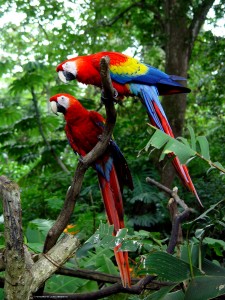The Scarlet Macaw is a large, red, yellow and blue South American parrot. It is a member of a large group of Neotropical parrots called Macaws. It is native to humid evergreen forests of tropical Central and South America. The Central American scarlet macaw is larger and has blue on its wings instead of green.
It is the national bird of Honduras. They inhabit humid lowland subtropical rainforests, woodlands, river edges and savannah normally in large groups. They are often seen flying above the rainforest canopy calling raucously to one another. It is about 32 inches long, of which more than half is the pointed and graduated tail and their average weight is about 1 kilogram. They have an almost featherless face with bare white skin around the eyes and a bright red plumage covering most of its body, wings and long tail.
They make very loud and high throaty squawks and screams designed to carry many miles to call for their groups. They have wide strong wings and hollow bones that aid flight but are generally not considered strong flyers. Most do not need to undertake long-distance flights. They will hang at odd angles to reach a delicious morsel using their feet and bill to grasp branches. It has a strong curved beak to crack hard nuts and seeds and a tongue that can hold onto the kernel to pull it from the shell. Nuts, leaves, berries and seeds from the rainforest make up the macaw’s diet. They can eat fruits toxic enough to kill other animals.
It is believed this is possible because they eat large amounts of clay, which is thought to neutralize plant poisons.
Scarlet macaws mate for life nesting from January to March. The female lays two or three white eggs in a tree cavity and then incubates the eggs for about five weeks. They preen each other and their offspring for hours, removing bugs from their feathers. The chicks fledge from the nest about 90 days after hatching and finally leave their parents about a year later. Males and females look the same.
While some learn to speak, most macaws have limited ability to mimic. Predators include the harpy eagle, snakes, jaguars and monkeys. The primary threats to the scarlet macaw are habitat loss and capture for the parrot trade.
Biologists hope that local governments will devote more attention to the protection of these magnificent birds.
Lloyd Boutcher
Director Sunvil Traveller





